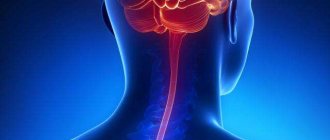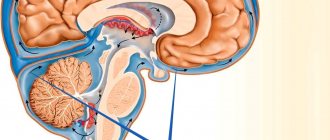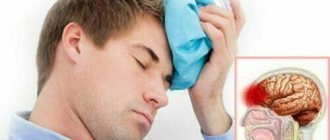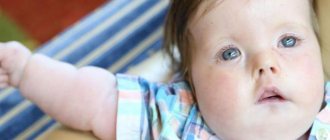Providing first aid to a child
The first thing the baby’s parents must do is call an ambulance.
There is no need to put off calling, much less try to treat your child on your own! Remember: the faster quality, qualified assistance is provided, the greater the child’s chances of recovery.
Before the arrival of specialists, it is necessary to provide the little patient with peace, silence and darkness. You should not let your child get up.
The same technique should be carried out in the case when a small patient experiences convulsions. This will protect the baby during an attack from the tongue retracting and blocking the respiratory tract.
Bibliography
- Medical microbiology, immunology and virology: a textbook for medical universities / A.I. Korotyaev, S.A. Babichev. - St. Petersburg: SpetsLit, 2008. - 4th ed., revised. and additional -767 pp.: ill.
- Yushchuk N.D. Infectious diseases: Textbook / N.D. Yushchuk, Yu.Ya. Vengerova. - M. GEOTAR-Media, 2013. - 692 p.
- Bogoleptov N.K. Clinical lectures on neuropathology / N.K. Bogoleptov. - M.: Medicine, 2012. - 431 p.
- Meningitis is dangerous, but curable. BUDGETARY INSTITUTION OF THE KHANTY-MANSI AUTONOMOUS DISTRICT – YUGRA. CENTER FOR MEDICAL PREVENTION.
- Differential diagnosis of neuroinfections in children. Kharkov, KhNMU, 2014
Meningitis in all its diversity
We have already mentioned that most often meningitis in children is of an infectious nature, they are different and differ depending on the pathogen. For example, viral meningitis often occurs against the background of viral infections such as chickenpox, rubella, measles, herpes infection, influenza, etc.
In children with immunodeficiency (for example, in patients with AIDS), fungal meningitis most often occurs.
As a rule, meningococcus enters the child’s body through the nasopharynx (airborne) and then spreads through the bloodstream - into the meninges, joints, lungs, internal organs, etc. Wherever meningococcus appears, it can cause an inflammatory process (meningococcal infection). If this happens in the membranes of the brain, it means that the child will have to be treated for meningococcal meningitis.
By the way, before the advent of antibiotics, every meningococcal meningitis ended in the death of a child and an adult. Nowadays, the mortality rate from meningococcal infection (including meningococcal meningitis) is also high - from 5 to 15% of the number of cases.
In addition to meningococcus, the causative agents of bacterial meningitis in children can be: pneumococci, staphylococci, Haemophilus influenzae, Koch's tuberculosis bacillus and other bacteria.
If there is any suspicion of meningitis, parents are required to seek medical help, preferably immediately to an infectious diseases clinic. Meanwhile, it will be useful for parents to know that, for example, most viral meningitis is not at all terrible. They go away on their own 5-7 days after the onset of inflammation, as soon as the immune system produces a sufficient amount of antiviral interferon.
But bacterial meningitis (and, alas, they are the majority) are much more dangerous! This group of meningitis in children is successfully treated, as a rule, only if antibacterial treatment was started on the first day after infection.
A 100% accurate method for confirming the diagnosis of meningitis in a child (and identifying the pathogen) is a spinal puncture.
What are the consequences of various forms of meningitis in children?
If a child is struck by meningitis and is not treated in a timely manner, the consequences are severe: problems with vision and hearing arise. Epileptic seizures and paralysis, difficulties in the mental development of the child.
Reactive meningitis leads to septic shock, blood clotting does not occur. In 10% of cases, the disease causes the death of children. Next, we will consider in more detail what the consequences of meningitis in children can be.
Nature of complications
The nervous system is subject to organic or functional disorders. Vision becomes worse to the point of blindness, the child becomes hard of hearing or completely deaf, vegetative-vascular dystonia and migraine develop. Organic lesions of the brain, cranial nerves and its membranes.
After an infectious process
The infectious process spreads to the brain and spinal cord. Meningoencephalitis develops and the roots of the nerve trunks are affected. This causes neuralgia and sciatica. If there is more cerebrospinal fluid, children are subject to hydrocephalus, weakened vision, and hearing loss.
After bacterial form
Bacterial meningitis is most often caused by meningococci, Pseudomonas aeruginosa and pneumococci. If the disease passes in a reactive form, then everything ends in death. If therapeutic measures are not carried out in a timely manner, the disease can be complicated by meningoencephalitis and hydrocephalus.
Consequences of bacterial meningitis in a child:
Consequences of meningitis for newborns and infants
The disease in newborns and infants is dangerous because the fluid pressure in the cavities surrounding the brain increases. The muscles at the back of the head tense, the baby constantly cries, turning his head, he is in great pain.
The nerves responsible for the eye and facial muscles are affected. The result is bulging or sunken eyes. The main danger of the disease is that a large amount of pus accumulates in the baby’s skull. There is a lot of pressure on the brain. This is accompanied by pain, the child constantly cries.
How long does recovery take?
Rehabilitation after illness in children takes a long time; it is impossible to indicate specific periods. It all depends on the type of illness, degree, age of the child and his state of health. If treatment is timely and adequate, the prognosis is favorable.
For complete recovery, complete rehabilitation of the body is indicated. After the child recovers, he is registered at the dispensary. A neurologist has been observing the child for 2 years. In the first 6 months, you should avoid flying on airplanes; you should not suddenly change climatic conditions. Intense physical activity is contraindicated. You can play sports only after complete rehabilitation.
To avoid recurrence of the disease, immunization of the child is mandatory.
Conclusion
If a child has suffered meningitis, adjustments are made to his lifestyle. Physiotherapy methods are indicated: classical massage, magnetic therapy, electrosleep, the function of the central nervous system is restored. All this is important because the consequences of meningitis in children can be very serious.
If you find an error, please select a piece of text and press Ctrl+Enter.
YOU MAY BE INTERESTED in: Meningitis in the eye Meningitis can be confused with Serous meningitis in Tyumen 2021 symptoms
The first signs of meningitis in a child
The incubation period of meningitis in children and adults can range from 2 to 10 days. Most often - from 4 to 6 days.
The development of inflammation of the meninges is characterized by the appearance of:
- a sharp increase in body temperature;
- severe headaches;
- repeated vomiting.
Patients also experience photophobia and a sharply negative reaction to loud sounds.
All the main symptoms of meningitis are divided into general infectious, cerebral and meningeal. The appearance of inflammatory changes in the cerebrospinal fluid is also specific.
How does meningitis manifest in children?
The clinical picture of general intoxication syndrome is characterized by the appearance of elevated body temperature, fever, chills, severe pallor, restless behavior in the child, and refusal to eat and drink.
Symptoms of meningitis in children
General cerebral signs of meningitis in children are manifested by intense pain in the head, localized mainly in the frontotemporal region and intensifying when the child tries to move the eyeballs. Loud noises and bright lights also lead to a sharp increase in headaches. Vomiting in patients with meningitis is repeated, does not bring relief, is independent of food intake and is not accompanied by nausea.
Impaired consciousness, development of psychomotor disorders, stupor, stupor or coma are possible. Seizures may develop.
For manifestations of meningeal syndrome, a forced lying position (posture of a pointing dog or cocked gun) is specific.
Pointing Dog Pose:
Pointer dog pose for meningitis
In addition to severe photophobia and increased pain sensitivity, specific meningeal symptoms develop (the main diagnostic signs of inflammation of the meningeal tract).
The main specific symptoms of meningitis in a child
The most commonly identified meningeal symptoms (signs) are:
stiff neck;
Rigidity of the neck muscles
Brudzinski's symptoms;
- Kerning's sign;
- Lessage's symptom (specific only to young children). It is manifested by the baby pulling his legs towards his stomach when he lifts his armpits;
Symptoms of meningitis according to Lessage
- Bekhterev's symptom, accompanied by the appearance of local pain when tapping on the zygomatic arches;
- Mondonesi's symptom, manifested by sharp pain with light pressure on the eyes.
The most characteristic signs of meningitis in a teenager or adult will be the symptoms of neck stiffness, Kerning and Brudzinski.
The development of meningococcemia is accompanied by the appearance of an extremely specific meningococcal rash. Meningitis rashes have a star-shaped irregular shape and are localized mainly on the buttocks and legs. The rash may also spread to the torso, arms and face. In the center of the elements of the rash, necrosis may appear. With severe meningococcemia, the elements of the rash may merge.
Skin rash due to meningitis
Meningitis rash
It should be noted that in babies in the first year of life, meningitis can lead to severe hydrocephalus in a very short period of time. For infants, typical signs of meningitis are the appearance of a high-pitched cerebral cry, pulsation and significant bulging of the large fontanel.
From the editor: How dangerous is a brain cyst?
Symptoms of meningitis in teenagers
For adolescents and adults, the presence of meningococcal nasopharyngitis preceding meningitis is more typical. Meningococcal nasopharyngitis differs from ordinary viral nasopharyngitis in its bluish-purple hue and pronounced granularity of the posterior pharyngeal wall.
Also characteristic is the appearance of high temperature, fever, weakness, dizziness, headaches, nasal congestion, hoarseness, etc. That is, there are no special differences from a regular acute respiratory infection.
The diagnosis of meningococcal nasopharyngitis is made only after bacteriological or serological tests. The development of meningococcal nasopharyngitis can be suspected by the presence of contact with a patient with inflammation of the bladder. In this regard, all patients with an acute respiratory viral infection who have had contact with the patient must be hospitalized in an infectious diseases hospital.
Nasopharyngitis can occur as a separate form of meningococcal infection, but in a short period of time they can turn into severe forms of inflammation of the bladder or meningococcemia.
Symptoms
Meningococcal infections have pronounced symptoms with the exception of mild forms of nasopharyngitis and meningococcal carriage. In the latter case, the person can be called conditionally healthy, since there are no complaints or clinical signs. The carrier, usually an adult, poses a threat to his environment, especially to children who are seriously susceptible to infection. On average, according to statistics, the carriage period is from 15 to 20 days.
Symptoms of acute nasopharyngitis
- Low-grade fever.
- Nasal congestion causing nasal speech.
- Sore throat, swelling, pain when swallowing.
- Paleness of the skin.
- Loss of energy, loss of appetite, headache.
Sometimes the disease manifests itself as vestibular disorders, resulting in dizziness, tinnitus, and nausea. There is no sneezing or coughing; sometimes there may be mucopurulent discharge from the nose. In general, the symptoms resemble acute respiratory infections, so it is important to carry out a differential diagnosis. On days 5–7, recovery occurs or the disease transitions to a generalized form.
Meningococcemia (meningococcal sepsis)
- Sudden onset of the disease, accompanied by a rise in temperature to +40 C.
- Severe headaches, photophobia, convulsions, vomiting.
- A pink or pink-red papular-type rash appears within 1–2 days. Spots of various sizes from 5 to 20 mm.
- Rigidity of the neck muscles - it is impossible to press the chin to the chest.
- Brudzinski's sign. When trying to pull his head to his chest, the patient involuntarily bends and pulls his legs towards his stomach.
- Kernig's sign. Alternately, the legs of the patient lying on his back are raised and bent at an angle of 90° at the knee joint. An attempt to return them to their original position fails, as muscle tone increases.
Of all the listed signs, hemorrhagic rashes are the most obvious. 2 days after their appearance, they become pigmented, forming ulcers and necrosis. In severe situations, pathological changes can lead to dry gangrene and subsequent amputation.
Meningococcal meningitis
- Rapid rise in body temperature to +40 °C.
- Severe headaches triggered by movement, touch, bright lights and loud noises.
- Repeated vomiting, independent of food intake, without relief.
- Low blood pressure, rapid pulse, shortness of breath.
The patient often assumes the fetal position - lying on his side with his hands tucked in, his legs clasped at the knees. Characteristic symptoms such as a stiff neck, Brudzinski's sign, and Kernig's sign may or may not be present. The disease is characterized by a high mortality rate; without proper treatment it reaches 50%. Survivors may show consequences of the infection: paresis, deafness, intellectual impairment, hydrocephalus.
Hypertoxic (fulminant) form of meningococcal infection
- Sudden rise in temperature to +40 C or more.
- The skin is cold, sticky with sweat. The patient has a fever and may have convulsions.
- Numerous hemorrhagic rashes appearing before the eyes. Small spots quickly merge into large hemorrhages of a purplish-cyanotic color. Skin changes resemble cadaveric spots.
- Blood pressure is low.
The hypertoxic form develops extremely quickly, within a few hours. Brain swelling occurs, accompanied by severe headaches, dizziness, vomiting, and loss of consciousness. This leads to infectious-toxic shock, a condition requiring immediate resuscitation. Without timely treatment, the patient may die.
Treatment
Important! Under no circumstances should you self-medicate. If the presence of this disease is suspected, the child is immediately hospitalized
Treatment is carried out under the close supervision of a doctor. The disease is very insidious, and at any moment the patient’s condition can worsen, even becoming critical.
Meningitis can cause irreversible damage to the brain and can also be fatal. That is why his treatment should be carried out in a hospital under the strict supervision of a doctor.
Important! Correct diagnosis and spinal puncture will help determine the form of the disease and select the correct treatment.
Treatment of meningitis in a child depends on what causes it (viruses or bacteria), as well as on its stage and the extent of damage to the meninges. The main form of treatment for this disease is the use of medications.
- The viral form of meningitis in children is considered the easiest to treat, since it is almost never accompanied by a bacterial infection. In this case, the basis of treatment is antiviral drugs that inhibit the interaction of the cell with the virus at different stages of the disease. The most commonly prescribed antiviral drugs are:
- Interferon – 120 rubles.
- Amantadine - in the form of tablets 200, and in the form of injections - 1350 rubles.
- Oksolin - average cost 60 rubles.
- Remantadine – 230 rub.
- Antibacterial drugs are prescribed for acute meningitis caused by various bacteria. Antibiotic therapy is also prescribed in cases where it is impossible to determine the causative agent of the infection. The most commonly prescribed drugs are:
- Amoxicillin - average price 130 rubles.
- Cefuroxime – 1300 rub.
- Aztreonam – 120 rub.
General recommendations
To alleviate the condition of a sick child, you should adhere to the following recommendations:
- Due to the increased sensitivity to light that appears after inflammation is relieved, the sick child should be in a darkened room.
- Provide complete rest to the child. He shouldn't be nervous or cry.
- Immunity should be boosted with vitamin complexes.
- It is recommended to follow a gentle diet, excluding hot dishes (even soups should be warm), sweets, fatty foods, marinades and pickles (they have a stimulating/irritating effect on the nervous system).
Remember:
- Under no circumstances should you rub or squeeze boils or large pimples on the neck or face.
- When the first symptoms of sinusitis, otitis media or any other disease develop, immediately obtain specialist advice regarding the effective treatment of one of these ailments.
- Ask your family doctor about the possibility of vaccination at the clinic.
ethnoscience
It is worth noting that treating this disease at home is unacceptable.
Many parents try to protect their child from taking medications, but in this case it can lead to disastrous consequences, even death. Treatment of meningitis in children should be carried out using special medications prescribed by a doctor. However, some traditional methods can complement treatment and have a beneficial effect on the body.
- For severe headaches, you can give your child decoctions of herbs such as barberry, meadowsweet. It is recommended to take such decoctions no more than 2 times a day, 1-2 tablespoons after meals.
- An infusion of medicinal lavender flowers helps well against cramps and spasms. To do this, you need to pour boiling water over 2 teaspoons of dry raw materials, and then let it brew for several hours. Should be taken 2 times a day, morning and evening.
- Linden tea is an excellent pain reliever and anti-inflammatory agent for meningitis. You need to brew a quarter cup of linden blossom with boiling water and let it brew for 10-15 minutes.
- During convulsions, a sick child is recommended to do a wrap. Salt must be diluted in warm water and soak the sheet in it. Then the child is wrapped in it, insulated and left in this position for 1 hour.
- Another good folk remedy is a bath with Veronica officinalis infusion. It is necessary to grind 200 g of raw materials and pour 2-3 liters of boiling water. After the decoction has infused, it is added to the bath water, the temperature of which should not exceed 37.5 degrees. The duration of the procedure should not exceed a quarter of an hour. The use of this folk remedy should be agreed with the attending physician.
What are the consequences of meningitis in children?
- What are the consequences of meningitis in children?
- What traumatizes a child’s psyche?
- How to remove anesthesia from the body after surgery
Consequences of meningitis
The degree of influence of the disease on the future life of the child depends on the scale of the damage caused by the infection. During recovery, a big role is played by the baby’s age, the state of the immune system, timely diagnosis of the problem and the correctness of the prescribed therapy.
1 in 5 children who have recovered from the disease may experience speech disorders and difficulties communicating with peers. The disease affects short-term and long-term memory, and some children may experience a significant decrease in intelligence quotient (IQ). Survivors of severe bacterial meningitis experience hearing loss in 2.4% of cases and require hearing aids.
Disorientation in space, loss of body balance, frequent headaches, problems with coordination, fatigue, paralysis or spasms of different parts of the body are no less common consequences of the disease. In medical practice, there are also cases of vision loss, which nevertheless can be considered relatively rare.
Degree of complications
The most destructive effect on brain activity is caused by bacterial meningitis caused by meningococcal infection. Weakened immunity and an early age of the baby are serious risks that can cause the development of large-scale lesions and even death. Pneumococcal invasion may be considered less serious, but even with it, the likelihood of undesirable consequences remains quite high.
Neonatal meningitis can occur during the first month of a child's life, but cases of complete recovery are not uncommon. Most often, normal recovery occurs in patients with a viral form of the disease, in which most signs of brain damage are temporary and become invisible after a relatively short period of time.
It should be noted that despite the availability of various antimicrobial drugs, meningitis causes the death of a large number of children. Modern diagnostic methods allow a quick conclusion to be made, however, treatment of the most serious forms of the disease requires hospitalization of the child. If the baby is not too sick, treatment at home is considered. With the wrong approach to stopping the disease, complications such as seizures, low blood pressure, and shock are possible. The heart, kidneys and adrenal glands can also be affected, although this is quite rare.
Symptoms of meningitis in infants
The disease develops quickly. Sometimes meningitis is preceded by otitis media or ARVI. The child develops a high fever, becomes restless and irritable, or, conversely, unusually lethargic. He reacts to touch by crying, as if his skin is irritated by something. The fontanel on the head thickens, swells and pulsates. The child may develop an aversion to food to the point of vomiting, and the occipital and posterior femoral muscles become tense. I may experience convulsions. An alarming symptom is the appearance on the child’s skin (usually on the legs and torso) of petechiae - purple pinpoint hemorrhages of various shapes and sizes that do not disappear with pressure.
Editor's note: How a pituitary adenoma is removed
If a child exhibits symptoms indicating meningitis, you should immediately seek medical help: call an ambulance or go to the hospital yourself!
Diagnosis of meningitis in newborns
Lumbar puncture for cerebrospinal fluid analysis. Complete blood count, levels of CRP, blood glucose, electrolytes; coagulogram, blood culture.
Diagnosis is based on microbiological methods (isolating a culture of microorganisms from cultures of CSF and blood). CSF cultures are positive in 70-85% of patients who have not previously received antibiotic therapy.
Negative cultures can be obtained during antibacterial therapy, brain abscess, infection caused by M. hominis, U. urealyticum, Bacteroidesfragilis, enteroviruses or herpes simplex virus. Infectious meningitis in newborns is characterized by an increase in protein content in the CSF and a decrease in glucose concentration. The number of leukocytes in the CSF is usually increased due to neutrophils (more than 70-90%).
Despite the wide variation in the cellular composition of the CSF, the generally accepted level of leukocytes in the CSF is >21 cells per 1 mm3 for culture-proven meningitis (sensitivity - 79%, specificity - 81%). Cytological and biochemical methods (changes in the cellular and biochemical composition of the CSF) are not always specific.
CSF glucose should be at least 55-105% of the blood glucose level in premature infants, and 44-128% in full-term infants. The protein concentration may be low (<0.3 g/L) or very high (>10 g/L).
There is no clear opinion on the need for CSF examination in patients with RNS. The American Academy of Pediatrics recommends performing a spinal tap on newborns in the following situations:
- positive blood culture;
- clinical or laboratory data strongly suggest bacterial sepsis;
- worsening during treatment with antimicrobial drugs.
If necessary, lumbar puncture can be delayed until the condition is stabilized, although there is a risk of delay in diagnosis and possibly inappropriate use of antibiotics. If a newborn with suspected sepsis or meningitis has abnormal CSF values, but blood and CSF cultures are negative, a repeat lumbar puncture should be performed to rule out anaerobic, mycoplasma, or fungal infection; It is also necessary to study the CSF for herpes, cytomegalovirus, and toxoplasmosis. Late analysis (delay greater than 2 hours) may significantly reduce the white blood cell count and glucose concentration in the CSF. The optimal time for delivery of material to the laboratory should not exceed 30 minutes.
Meningitis with normal indicators. Up to 30% of newborns with GBS meningitis may have normal CSF values. In addition, even microbiologically confirmed meningitis does not always lead to changes in the cellular composition in the CSF. Sometimes, in addition to increased CSF pressure, no other pathology in the CSF may be detected or the indicators may be “borderline”. In doubtful cases, for example, with “borderline” values of CSF parameters (leukocytes > 20 in 1 mm3 or protein > 1.0 g/l), in the presence of clinical symptoms, it is necessary to examine newborns for the presence of specific infections (syphilis, rubella, cytomegalovirus, herpes, AIDS virus).
Microscopy with Gram stain. Organisms in Gram-stained CSF smears are detected in 83% of neonates with GBS meningitis and in 78% of those with Gram-negative meningitis.
The likelihood of bacteria being visualized on a Gram stain correlates with the concentration of bacteria in the CSF. CSF culture is critical to diagnosis, regardless of other findings. A complete examination of the CSF is all the more necessary, since the pathogen isolated from the blood will not always match the CSF culture.
Ventricular puncture should be considered for meningitis that does not respond clinically or microbiologically to antibiotic therapy due to ventriculitis, especially if there is obstruction between the cerebral ventricles and between the ventricles and the spinal canal.
Consequences in adults
Some people who have had meningitis are lucky - after treatment they remember the disease as a bad dream and do not face any serious health problems, with the exception of headaches that almost do not interfere with life, arising from overwork or changes in weather.
Sometimes meningitis reminds itself of itself by decreased concentration and attention, as well as worsened memory.
However, those who recovered often experienced loss of hearing or vision, stuttering or strabismus, developed epilepsy, dropsy of the brain, or a decrease in their level of intelligence.
A person who has had meningitis may also experience mental disorders, including the development of schizophrenia.
Depending on the cause of the disease and its causative agent, problems associated with internal organs may also appear. Often a person’s limbs were even amputated due to developed necrosis.
Fortunately, with the modern level of medicine, this disease can be successfully treated: it is unlikely that a person who sees a doctor in time will remain disabled for life. He will not necessarily become weak-minded - often those who have had meningitis continue to build a career or receive a second higher education.
If a person has had a purulent form of meningitis, he or she becomes immune to the specific bacterium that causes the disease. But he can become infected with meningitis more than once. By the way, most often only people with skull injuries get it again.
Meningitis is a disease that should never be joked with.
It is important to remember that everything can end happily if the patient is taken to the doctor on time. The main thing is not to lose composure and not to panic, but to dial the emergency number as soon as possible
From the editor: How to develop memory in preschool children
In order to protect yourself and your loved ones, you need to know how meningitis is transmitted and what are the first symptoms of this insidious disease. Everyone should know this.
Based on the nature of the headaches, we can talk about possible diseases. You can find out how headaches with a brain tumor manifest themselves by following this link.
Complications and consequences
Since meningitis affects the membranes of the brain, it is obvious that the consequences and complications from such a disease will be extremely severe. Unfortunately, in each case it is impossible to reliably predict what the consequences of meningitis will be, how severe they will be and whether it will be possible to get rid of them.
One of the most common complications from meningitis is asthenic syndrome. This is when a person gets tired quickly, cannot control his emotions, is unable to work for a long time mentally or physically, is weak, and irritable. A person may also experience chronic headaches, and sometimes cramps.
List of complications:
- retardation in intellectual, mental and physical development;
- partial deafness or blindness;
- paralysis;
- ischemic stroke;
- hydrocephalus.
Unfortunately, although very rarely, death occurs. That's why this disease is so terrible.
Causes of the disease
There are many reasons for its occurrence, but most are similar in that a harmful pathogen (virus, bacteria, fungus, etc.) enters the body, which is why the disease develops. Therefore, in this case, it is more appropriate to talk about transmission routes and risk groups.
You can become infected with meningitis:
- by airborne droplets (both from the patient and from the carrier);
- through rodent and insect bites;
- by the oral-fecal route (residues of rodent excrement on unwashed vegetables or fruits);
- when drinking dirty water;
- through contact and household contact (again, both from the patient and from the carrier);
- during childbirth.
There are also cases of traumatic meningitis, when due to a head injury (trauma to the base of the skull, open fracture of the skull), pus flows out and the pathogen enters through the mucous membrane, ear canal or wound.
Most often the disease is affected by:
- children under 5 years old;
- premature babies;
- children who had a difficult pregnancy (pregnancy had complications);
- children who have suffered purulent diseases (otitis media, tonsillitis, sinusitis, etc.);
- children suffering from nervous system disorders (acquired or congenital);
- children who have not been vaccinated against meningococcus, rubella, measles, Haemophilus influenzae, mumps;
- children with acquired or congenital immunodeficiency;
- children who attend preschool or have frequent contact with large numbers of people;
- people with weakened immune systems.
Since immunity plays an important role in whether meningococcus or any other microorganism will be able to penetrate the body and take root there, it is worth mentioning the factors that reduce immunity.
The following weakens the body:
- stress;
- smoking;
- excessive use of alcohol or drugs;
- hypothermia;
- unbalanced diet;
- lack of vitamins;
- improper use of medications (self-medication);
- head, neck, back injuries;
- chronic diseases (bronchitis, HIV infection, diabetes, etc.);
- past infections (rubella, otitis media, acute respiratory infections, acute respiratory viral infections, etc.).
You should also remember that you can get meningitis more than once.
Differential diagnosis of pathology
After examining and interviewing parents, the following procedures are prescribed:
Cerebrospinal fluid examination.
When the diagnosis is confirmed, an increase in protein levels is detected in the cerebrospinal fluid with a normal glucose concentration. An increase in lymphocytes means the viral nature of the disease. After the puncture, the child feels much better.
Serological examination of cerebrospinal fluid in the blood.
This test helps identify the virus that caused the disease and find antibodies to it.
PCR of cerebrospinal fluid.
Can detect viral DNA. This is the final analysis aimed at confirming or refuting a specific virus.
Inoculation of cerebrospinal fluid on a nutrient medium.
The doctor may prescribe additional tests to make sure which form of the disease has overcome the baby. .
What is the difference between viral and bacterial meningitis
Bacterial differs in that it is provoked by streptococcal bacteria. This type attacks people with HIV, those who have undergone surgery in the abdominal area, and those with alcohol addiction.
This type is detected by laboratory analysis of cerebrospinal fluid.
Meningitis: negative consequences and methods to minimize them
Meningitis: what is this disease?
We are talking about inflammation of the meninges. It can occur as an independent disease or become a complication of another disease. Types of meningitis are distinguished according to several characteristics: the nature and prevalence of inflammation, the speed of its development and severity.
By the nature of inflammation, meningitis can be serous, when lymphocytes predominate in the cerebrospinal fluid (the fluid that washes the brain), or purulent, when the predominance of neutrophils in the cerebrospinal fluid creates a purulent exudate.
According to the prevalence of inflammation, meningitis is classified as generalized (widespread) or limited (for example, only in the hemispheres or base of the brain).
According to the speed of development of the disease, meningitis is divided into:
Chronic meningitis is most often secondary, that is, caused by an infection that already existed in the body and moved to the meninges. This is, for example, meningitis due to tuberculosis or neurosyphilis.
According to the severity, meningitis can be:
- light;
- moderate severity;
- heavy;
- extremely heavy.
Meningitis can be caused by bacteria (most often meningococci), viruses (enterovirus), protozoa (meningitis due to malaria, toxoplasmosis) and even fungi. However, fungal meningitis occurs only with reduced immunity.
The disease most often occurs acutely and begins with a high temperature - 38.6–39.6°C. A severe headache and vomiting appear, after which there is no relief, unlike banal food poisoning. So-called meningeal symptoms are added, the most obvious of which is neck rigidity: the patient cannot, tilting his head forward, reach his chin to his chest. Feeling dizzy, photophobia and drowsiness appear. Loss of consciousness and convulsions are possible.
Meningococcal meningitis is accompanied by a characteristic skin rash; with other forms of meningitis, there may be no rash if the disease is not accompanied by sepsis.
An increased level of neutrophils or leukocytes is determined in the blood, depending on the nature of the inflammation, and a high ESR.
Bacterial meningitis has long been considered a disease primarily of children—for example, as of 1986, the average age of patients with bacterial meningitis was 15 months [1]. The active introduction of vaccination has led to the fact that in world practice purulent meningitis has become a disease of adults - already in 1998, the average age of patients was 25 years. But in Russia, vaccination against meningococcal and pneumococcal infections is not included in the vaccination calendar and the situation remains the same: children get sick more often. Purulent meningitis accounts for 33% of all infectious diseases of the nervous system in children. 23% are serous meningitis [2].
Among meningitis of a viral nature, enteroviral ones predominate, all over the world predominantly affecting people under 18 years of age [3]. In Russia, enterovirus is the cause of 74% of all viral meningitis in children [4].
In adults, the causes of acute meningitis do not differ from those in children, except that Haemophilus influenzae becomes more noticeable - up to 10% [5].
Among chronic meningitis, one of the most common is tuberculosis, the frequency of which in countries with an unfavorable situation for this disease (which, unfortunately, includes the countries of the former USSR) ranges from 62 to 411 cases per 10 thousand people.
Complications after meningitis
Bacterial meningitis is lethal in approximately 10% of cases; the mortality rate for viral meningitis, if the process does not develop into encephalitis, does not exceed 1% [6].
The most common and relatively harmless consequence after meningitis is asthenic syndrome: causeless malaise, weakness, low mood. It can last from 3 to 12 months [7] .
But, according to American doctors, serious neurological consequences of meningitis remain in almost 30% of cases [8], these are:
- intellectual disabilities;
- paresis, paralysis;
- blindness;
- deafness (sensorineural hearing loss);
- hydrocephalus;
- convulsive syndrome;
- ischemic stroke (in adults it accounts for up to 25% of all complications).
It is impossible to predict in advance how severe the complications after meningitis will be and whether they can be eliminated.
Diagnosis of the disease
Despite the fact that the basis of diagnosis is a thorough interview and detailed examination of the patient, the list of necessary studies for suspected meningitis is quite long. It includes:
- collecting anamnesis and examining the patient, identifying cerebral and meningeal symptoms;
- general blood test - reveals inflammatory changes;
- general urinalysis - in severe cases and sepsis, kidney damage is possible;
- spinal puncture and examination of cerebrospinal fluid - the fluid that washes the brain and spinal cord;
- biochemical blood test - determines the degree of damage to other internal organs;
- bacteriological culture of mucus from the nasopharynx for meningococcus, pneumococcus;
- if purulent meningitis is suspected, bacteriological examination of cerebrospinal fluid and blood;
- if serous meningitis is suspected, stool testing for enteroviruses and polio viruses (PCR);
- if you suspect mumps (“mumps”), test IgM for mumps; if you suspect a herpes virus, test the level of IgM for herpes viruses type 1 and 2.
- in severe cases and the development of infectious-toxic shock, blood is taken for acid-base balance and analysis of the coagulation system.
It is also possible to add other studies - for example, in a serious condition and signs of heart damage - an ECG, if pneumonia is suspected, which may be the case with pneumococcal meningitis - a chest x-ray; it is possible to identify pathogens not listed above.
Treatment
If you suspect meningitis, you should immediately call an ambulance - hospitalization is necessary. Which department the patient will be hospitalized in depends on the cause of the disease. For viral and bacterial meningitis, the patient is sent for treatment to the infectious diseases department. If meningitis occurs as a complication of purulent otitis or sinusitis, go to the ENT department. If tuberculous meningitis is suspected, the patient is sent to a tuberculosis dispensary.
High fever is brought down with non-steroidal anti-inflammatory drugs, such as paracetamol, ibuprofen.
If there are signs of a bacterial infection, broad-spectrum antibiotics are used. Dosages and duration of the course will depend on the chosen agent and the intended pathogen. After receiving the results of a bacteriological study, the antibiotic can be replaced taking into account the sensitivity of the pathogen to it.
Viral meningitis is treated with antiviral agents; for tick-borne encephalitis, therapy is supplemented with anti-tick immunoglobulin.
If seizures occur, anticonvulsants and drugs to reduce intracranial pressure are prescribed.
To reduce general intoxication, detoxification therapy is carried out: in parallel with intravenous infusions, “droppers”, diuretics (diuretics) are prescribed. In this case, it is necessary to strictly monitor the general condition, the volume of urine excreted, and central venous pressure. Detoxification therapy is not carried out if cerebral edema is suspected.
Glucocorticosteroids (dexamethasone) are used as anti-inflammatory therapy. By reducing the activity of inflammation, they reduce the likelihood of an unfavorable outcome and the occurrence of long-term consequences of meningitis.
If necessary, perform artificial ventilation.
If meningitis is secondary, treatment of the underlying disease is mandatory: surgical treatment for purulent inflammation of the ENT organs, taking anti-tuberculosis drugs.
Rehabilitation after meningitis
After meningitis, the patient is observed by a neurologist for at least 2 years. In the first year, an inspection is required once every 3 months, then once every six months.
Recovery from meningitis is a complex, complex and multifaceted process. Here are its components:
- Diet . The goal of nutrition after meningitis is to restore strength without irritating the gastrointestinal tract. Of the cooking methods, it is better to prefer boiling, including steaming, baking, and stewing. Meat is recommended mainly of low-fat varieties: rabbit, veal, chicken. Lean fish. For children, it is better to cook meat and fish in chopped form: cutlets, souffles, pates; adults do not need to chop it. Well-cooked porridge is suitable as a side dish. Vegetables and fruits also need to be heat treated: coarse fiber can irritate the mucous membrane that has become temporarily sensitive. Fruit purees, soups, stewed and baked vegetables are essential in the diet. Dairy products can serve as an additional source of protein. From drinks, compotes and jelly, weak tea are appropriate.
- Physiotherapy . Includes both classic massage and various types of hardware techniques. Electrophoresis of vitamins and some medications allows you to either relax or, conversely, stimulate the desired muscle groups. For coordination and cognitive (related to memory and understanding) disorders, electrosleep, magnetic therapy, magnetic laser therapy, and restoration of the functions of the central nervous system are used. Other methods are also used, which should be selected by a competent physiotherapist to treat the consequences of meningitis based on the condition of a particular patient.
- Physiotherapy . This is also a separate and extensive area of recovery after meningitis. An exercise therapy specialist helps the patient restore movement skills, gradually and consistently training first individual parts of the motor act, then the “connections” between them, moving on to more and more complex interactions. Modern rehabilitation centers use not only gymnastics, but also special suits with feedback, robotic simulators and other methods that until recently seemed fantastic.
- Occupational therapy . This is a set of methods that is aimed at everyday adaptation of the patient. Any disease forces you to change your lifestyle, especially if the disease takes away some of your physical capabilities. Ergotherapy, on the one hand, helps to at least partially restore range of motion, strength, and coordination. On the other hand, as part of the rehabilitation system after meningitis, it helps to adapt the existing limited capabilities to the patient’s habits and lifestyle, teaches him to feel like a full-fledged person and enjoy life, regardless of physical limitations.
- Cognitive therapy is exercises aimed at restoring attention, memory, and logical thinking.
Meningitis is a serious illness that leads to serious complications. Recovery from meningitis is a long and painstaking process that requires knowledge and experience from doctors, and persistence, consistency and patience from patients and their loved ones.










